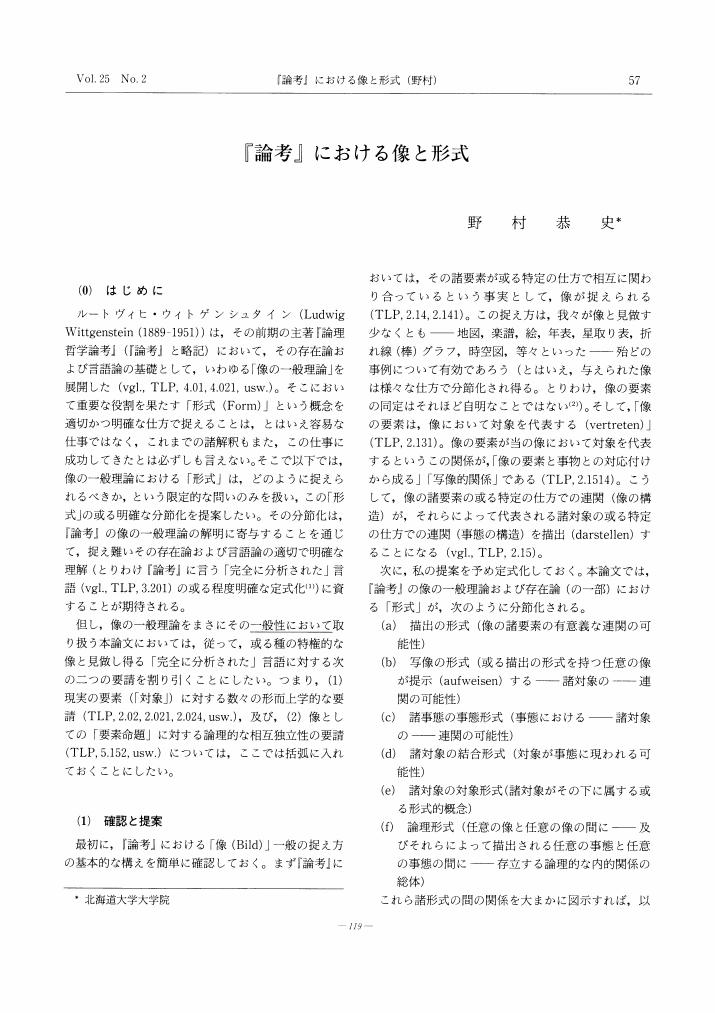5 0 0 0 OA ウィトゲンシュタインにおける言語・論理・世界 : 『論考』の哲学 その生成から崩壊まで
3 0 0 0 OA 「ポチは白い」は要素命題でありうるか 野矢茂樹著『『論理哲学論考』を読む』を読む
- 著者
- 野村 恭史
- 出版者
- 日本科学哲学会
- 雑誌
- 科学哲学 (ISSN:02893428)
- 巻号頁・発行日
- vol.37, no.1, pp.61-75, 2004-07-25 (Released:2009-05-29)
One of alleged problems of Wittgenstein's Tractatus logico-philosophicus (TLP) is that we could give no example of its basic concepts such as elementary propositions, names, states of affairs, simple objects, and so on. The problem is so serious, because it means that the whole theoretical system of TLP could have no applicability. Noya, in his recent book on TLP, proposes to regard ordinary objects familiar to us in our daily life, such as persons, dogs, mountains, rock bands, and so on, as examples of simple objects of TLP. But, I think, we cannot interpret TLP in the way his proposal suggests. In this paper I shall show there is no sense in which we can say ordinary objects are simple objects of TLP. There are two main reasons. One concerns TLP's requirement of logical independency of elementary propositions, and the other concerns TLP's requirement that simple objects should exist independently of what is the case.
2 0 0 0 OA 「付録B」タイプ理論とは何だったのか
- 著者
- 野村 恭史
- 出版者
- The Philosophy of Science Society, Japan
- 雑誌
- 科学哲学 (ISSN:02893428)
- 巻号頁・発行日
- vol.53, no.2, pp.45-63, 2021-03-31 (Released:2021-03-31)
- 参考文献数
- 18
In the “Appendix B” to his Principles of Mathematics (1903), Bertrand Russell developed a theory of types that is different explicitly from his so-called “ramified” theory of types in Principia Mathematica (1910). It is not easy to evaluate properly this “Appendix B” theory of types, because (A) it is sometimes thought that it is only a rough sketch added hastily, and (B) it seems to play no role for Russellʼs later theoretical developments. But in this paper, I shall show that both (A) and (B) are not correct and that the “Appendix B” theory of types played an important role for his theoretical developments leading to the ramified theory of types.
2 0 0 0 OA 『数学の原理』におけるラッセルのパラドクスと命題関数の理論
- 著者
- 野村 恭史
- 出版者
- The Philosophy of Science Society, Japan
- 雑誌
- 科学哲学 (ISSN:02893428)
- 巻号頁・発行日
- vol.46, no.1, pp.17-33, 2012 (Released:2016-01-13)
- 参考文献数
- 27
Bertrand Russell has found the paradox that bears his own name in the spring of 1901 and offered a version of the so-called “simple” theory of types as measures against it in an appendix to The Principles of Mathematics (1903). This theory was devised to deal with the class-version of that paradox. But he formulated it also in terms of “predicates” and the type theory has no effect to this formulation. In this paper, I shall show that Russell offered measures also against the “predicate”-version of that paradox in the Principles and it is very interesting in a sense that it enables to avoid the paradox without forbidding self-predications of predicates in general.
2 0 0 0 OA ウィトゲンシュタイン最後の思考―確実性と偶然性の邂逅
- 著者
- 野村 恭史
- 出版者
- The Philosophy of Science Society, Japan
- 雑誌
- 科学哲学 (ISSN:02893428)
- 巻号頁・発行日
- vol.44, no.1, pp.1_49-1_57, 2011 (Released:2011-10-13)
- 参考文献数
- 11
Keiichi Yamada’s first and recent book, The Last Thinking of Wittgenstein: An Encounter between Certainty and Contingency, aims at bringing out it into relief Wittgenstein’s philosophy of knowledge that is embodied especially in his “last” thinking, which the author extracts mainly from On Certainty, and locating it in the context of contemporary discussions on knowledge. This book should be interesting very much not only to Wittgenstein scholars but also to those who are engaged in philosophy in general. I shall make several and somewhat critical comments.
1 0 0 0 OA 「論理は超越論的である」(『論考』六・一三) 汎論理主義者ウィトゲンシュタイン
- 著者
- 野村 恭史
- 出版者
- 日本哲学会
- 雑誌
- 哲学 (ISSN:03873358)
- 巻号頁・発行日
- vol.2022, no.73, pp.66-82, 2022-04-01 (Released:2022-07-21)
- 参考文献数
- 22
1 0 0 0 OA 『数学の原理』におけるラッセルのパラドクスとクラスの理論
- 著者
- 野村 恭史
- 出版者
- 科学基礎論学会
- 雑誌
- 科学基礎論研究 (ISSN:00227668)
- 巻号頁・発行日
- vol.41, no.1, pp.23-36, 2013-11-30 (Released:2017-08-31)
- 参考文献数
- 27
We can regard Russell's theory of classes in The Principles of Mathematics as a dual theory of classes based upon the distinction between a class as one and a class as many. In this paper, I shall show the following (A)-(D) from the viewpoint of how Russell dealt in the Principles with the paradox that bears his own name. (A) The dual theory of classes is one that deserves serious considerations. (B) Russell offered measures against the paradox other than the simple theory of types developed in an appendix to the Principles. (C) Russell avoided the paradox without forbidding self-memberships of classes in general. (D) Though introducing a hierarchy of types into pseudo-entities is a very important step to Russell's later theories (e.g., the substitutional theory and the ramified theory of types), we can find this strategy already in the Principles.
- 著者
- 野村 恭史
- 出版者
- 科学基礎論学会
- 雑誌
- 科学基礎論研究 (ISSN:00227668)
- 巻号頁・発行日
- vol.33, no.2, pp.79-87, 2006-03-25 (Released:2010-01-20)
- 参考文献数
- 38
1 0 0 0 OA 『論考』における像と形式
- 著者
- 野村 恭史
- 出版者
- 科学基礎論学会
- 雑誌
- 科学基礎論研究 (ISSN:00227668)
- 巻号頁・発行日
- vol.25, no.2, pp.119-124, 1998-03-31 (Released:2009-07-23)
- 参考文献数
- 6
1 0 0 0 OA プレ『論考』期におけるウィトゲンシュタイン意味論の変遷
- 著者
- 野村 恭史
- 出版者
- 日本科学哲学会
- 雑誌
- 科学哲学 (ISSN:02893428)
- 巻号頁・発行日
- vol.33, no.1, pp.43-53, 2000-05-15 (Released:2009-05-29)
The metaphysics of "simple" objects and the syntactic theory of "expressions (Ausdrücke)" can be seen as theoretical foundations of Wittgenstein's Tractatus Logicophilosophicus. I shall show in this paper how these two doctrines result from his struggling with Russell's theory of types, and establish the early Wittgenstein's basic idea that structural (formal) features of language mirror structural (formal) features of the world. In order to do so, I will trace the basic line of Wittgenstein's thought back to the pre-Tractatus period.


